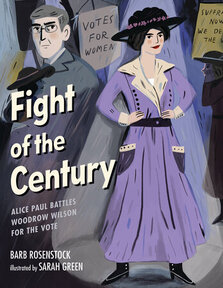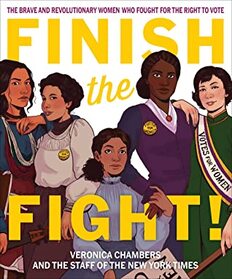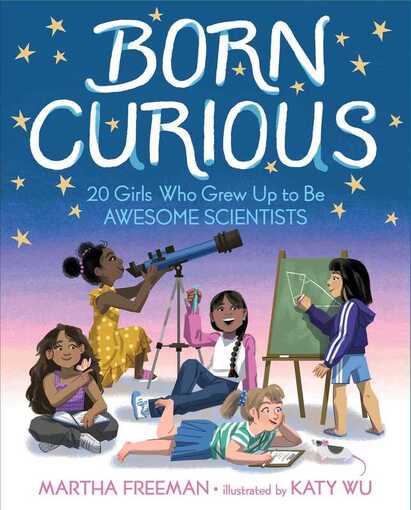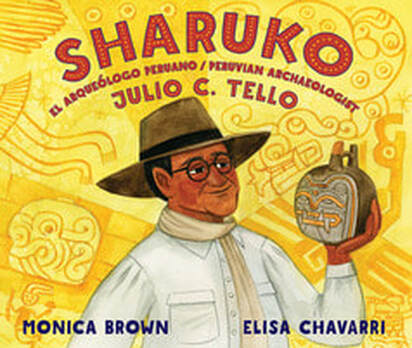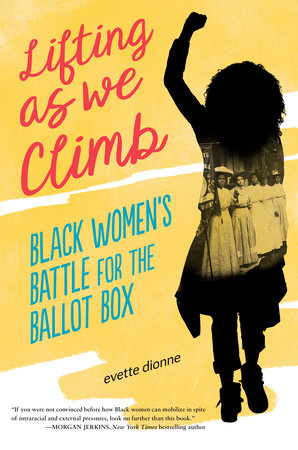Additional Resources
Real People, Real Classrooms: Introducing the Biography Clearinghouse
by Mary Ann Cappiello, Lesa Cline-Ransome, Xenia Hadjioannou, Barb Rosenstock, and Tanya Lee Stone
|
|
Enjoy this conversation with some of our featured authors and founding members as they discuss their creative processes and how educators can bring biographies to life in classrooms.
|
Three Tips for Biography Read-Alouds
by Courtney Shimek
2020 has changed our world in indelible ways. From navigating a global pandemic to fighting social injustices embedded into our everyday lives, we find ourselves overwhelmed, exhausted, and uncertain of the future. In response to these crises and the emotions they produce, we have found solace in picturebook biographies that deliver some much-needed perspective. Reading biographies have become a part of our self-care; they provide archives of the past, context for the present, and hope for the future. At The Biography Clearinghouse, we recognize the potential of biographies to shape readers’ understanding of the world, inform their connection to history, and engender empathy. Through our teaching ideas, we suggest ideas and resources for incorporating biographies into curricula. We also recognize that sometimes picturebook biographies come to life most vividly when read-aloud with young readers.
As we maintain our "new normal" of vacillating between online, hybrid, and in-class instruction, reading aloud continues to be a constant beacon of inspiration and connection in our teaching. Our youth are navigating the same chaotic and ever-changing world; given that biographies model the complexities of this world, sharing these perspectives with youth is vital. As such, I share here 3 tips for reading biographies aloud and a few illustrative examples of high-quality biographies.
As we maintain our "new normal" of vacillating between online, hybrid, and in-class instruction, reading aloud continues to be a constant beacon of inspiration and connection in our teaching. Our youth are navigating the same chaotic and ever-changing world; given that biographies model the complexities of this world, sharing these perspectives with youth is vital. As such, I share here 3 tips for reading biographies aloud and a few illustrative examples of high-quality biographies.
Tip #1: Discuss the Visual Features
|
Picturebooks are unique artifacts where readers gain information not only from words but also from images. The visual features of biographies provide insights into the emotional experiences of distinctive individuals and offer a deeper understanding of humanity. As you read biographies aloud, begin examining the artistic elements (e.g., design and composition, font styles, use of color, artistic mediums, etc.) and see what you discern about the featured individuals, their emotions, and their experiences. For example, from the beautiful mixed media artwork in Spotted Tail (Weiden et al., 2019), we see how the history of the Lakota people connects to present-day issues through striking photographs, art, textural elements from nature, and quotes.
|
Though Spotted Tail has a text-heavy narrative, the design and combination of photographs and art from Jim Yellowtail and Pat Kinsella provide readers numerous points of discussion and a perspective worth including in your read-aloud rotation. Additionally, in It Began With a Page: How Gyo Fujikawa Drew the Way (Maclear & Morstad, 2019), Morstad’s illustrations show the reader the detail and sense of color Fujikawa used in her work, and real photographs of her family are included throughout the book. In addressing the visual features of books with readers, we learn about people’s beliefs, histories, cultures, and emotions, and learn more information than from the words, alone.
Tip #2: Back Matter Matters
|
Often, when we begin a read-aloud we skip to the beginning of the narrative and stop at the end, but creators of contemporary biographies share exceptional amounts of information in the peritextual elements, or everything in the book which is not the actual narrative. Instead of stopping your read-aloud at the end of the narrative, share some of the information included in the back matter such as authors’ and illustrators’ personal connections to the content, where they sourced research materials, and their creative processes. For example, in Planting Stories: The Life of Librarian and Storyteller Pura Belpré (Denise & Escobar, 2019), Denise provides descriptions of books by Pura Belpré, as well as films, books, and collections about Pura Belpré for further study. Similarly, in A Place to Land: Martin Luther King, Jr. and the Speech that Inspired a Nation, Barry Wittenstein and Jerry Pinkney (2019) provide notes expanding upon their decisions, short biographies about other civil rights leaders, along with sources and a bibliography.
|
Biography creators also include additional content through the book jacket, endpapers, and their dedications. Sometimes, the back matter or other peritextual features might be more text-heavy or smaller in size than the narrative. We suggest projecting these features or displaying them on an interactive whiteboard so that these peritextual features can be explored and discussed collectively. When we only read aloud the primary narrative, we miss out on information that contextualizes the biography, describes the creative process, and inspires readers to search out additional sources.
Tip #3: Revisit Writer's Language
|
Biographers don’t just share events with readers, they share the essence of a person’s life. After you read a biography aloud, reread the book like a writer and examine how the authors’ word choices shape your understandings of a person, place, or event. In Fight of the Century: Alice Paul Battles Woodrow Wilson for the Vote (Rosenstock & Green, 2020), for example, Rosenstock structures her biography as a boxing match between Alice Paul and Woodrow Wilson. By portraying major events as rounds and including commentary from fight announcers (e.g., “This fight determines whether the women of the United States can vote, folks!”), readers experience how progress is often a battle of wills and experience what a fighter Alice Paul was. Additionally, Nelson’s use of western idioms (e.g., “plain as the ears on a mule” and “fit like made-to-measure boots”) in Let ‘er Buck!: George Fletcher, the People’s Champion (Nelson & James, 2019), drops the reader into the cowboy language and culture of Pendleton, Oregon. Through similes and energetic descriptions of bull riding, we experience how Fletcher was discriminated against and, yet, became a hometown hero. Biographers’ language choices provide us with new ways of looking at historical events, embed us in particular moments of time, and supply inspiration for our own writing processes.
|
The six exemplar biographies referenced in this post are just some of the contemporary picturebook biographies that evoke engaging, artistic, and dynamic read-alouds. If you’re interested to know more about biographies and how to include them in your curriculum, join Tanya Lee Stone, Lesa Cline Ransome, Barb Rosenstock, and members of The Biography Clearinghouse and the Children’s Literature Assembly, Xenia Hadjioannou and Mary Ann Cappiello, as they engage in conversations about biographies in their Stimolalive Conversation: Real People, Real Classrooms.
20 Biographies for 2020
by Mary Ann Cappiello
|
As we approach the final quarter of 2020, fires rage along the West Coast. Many regions of the United States face drought conditions. Gulf communities are inundated by Hurricane Sally while a string of storms line up in the Atlantic, waiting their turn. The impact of climate change is evident.
COVID-19 continues to wreak havoc on our lives, our health. We bear witness to the disproportionate impact of COVID-19 on minoritized groups, including Black and Latinx communities, Native Americans, and the elderly. |
Across America, Black Lives Matter protests carry on, demanding that our nation invest in the essential work necessary to achieve a more perfect union through racial justice.
In 2020, we remember moments of historic change, commemorating the 30th anniversary of the Americans with Disabilities Act and the 100th anniversary of the 19th Amendment.
In 2020, we remember moments of historic change, commemorating the 30th anniversary of the Americans with Disabilities Act and the 100th anniversary of the 19th Amendment.
|
The intensity of this moment can’t be denied. It’s demanding. It’s exhausting. Whether you are a teacher, librarian, or university faculty member, you are likely teaching in multiple new formats and modalities, facing daily logistical challenges. Caregivers also face new hurdles in supporting young people’s learning.
How do you meet the needs of students and the needs of this moment in history? How do you find hope in literature? Perhaps one way is to turn to the people of the past and the present who are working on the edges of scientific knowledge. Or, to turn to the people of the past and the present who have acted as champions of social justice. Their life stories offer young people models of agency and action, blueprints for change. |
To that end, The Biography Clearinghouse shares 20 biographies for 2020, a list of recent picturebook and collected biographies to connect with the challenges of the moment. This list is not comprehensive. It is simply a starting place. We hope these recently published biographies of diverse changemakers can become part of your curriculum or part of your read aloud calendar, in-person or over video conferencing software.
Biographies about Scientists
Biographies about Champions for Change
|
All the Way to the Top: How One Girl’s Fight for Americans with Disabilities Changed Everything (2020) by Annette Bay Pimental, illustrated by Nabi H. Ali
Althea Gibson: The Story of Tennis’ Fleet-Footed Girl (2020) by Megan Reid, illustrated by Laura Freeman Finish the Fight: The Brave and Revolutionary Women Who Fought for the Right to Vote (2020) by Veronica Chambers and the staff of The New York Times, illustrated by Monica Ahanonu, Rachelle Baker, Kristen Buchholz, Alex Cabal, Noa Denmon, Ellen Duda, Shyama Golden, Johnalynn Holland, Hillary Kempenich, Nhung Lê , Ella Trujillo, and Steffi Walthall I am Not a Label: 34 Disabled Artists, Thinkers, Athletes and Activists from Past and Present (2020) by Cerrie Burnell, illustrated by Lauren Mark Baldo Lifting as We Climb: Black Women’s Battle for the Ballot Box (2020) by Evette Dion Lizzie Demands a Seat! Elizabeth Jennings Fights for Streetcar Rights (2020) by Beth Anderson, illustrated by E.B. Lewis She was the First! The Trailblazing Life of Shirley Chisholm (2020) by Katheryn Russell-Brown, illustrated by Eric Velasquez Soldier for Equality: José de la Luz Sáenz and The Great War (2019) by Duncan Tonatiuh Spotted Tail (2019) by David Heska Wanbli Weiden, illustrated by Jim Yellowhawk and Pat Kinsella The Teachers March: How Selma’s Teachers Changed History (2020) by Sandra Neil Wallace and Rick Wallace, illustrated by Charly Palmer |
If you have any picture book or chapter-length biographies or collected biographies for young people that you would like to recommend, please email us at [email protected]. We’re also interested in hearing more about how you’re using life stories in the classroom this year.



